The interactive map is currently not available.
Well, as I thought, I wasn't able to get live coverage of the eclipse up. Sorry! But I was trying to chasing the sunshine across Cornwall -- or I would have been, if there had been any.
So here's my personal eclipse experience, for what it's worth. I got a few pictures, mainly of cloud.
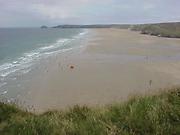
The huge, beautiful golden beach at Perranporth — mostly empty
 Tue 10 Aug 1999 Europe/London
Tue 10 Aug 1999 Europe/London
Well, it was cloudy -- totally -- in the morning, which isn't too hopeful. Unfortunately, the weather forecast is even worse!
On the other hand, the crowds that were supposed to be here aren't -- Cornwall is busy in places, but generally quiet. Perranporth beach was almost deserted today! And some friends made the trip from Wells to Truro today -- yes, the day before! -- with no trouble at all.
So today Rob and I hiked from St. Agnes to Perranporth and back (about 8-9 miles). The Sun came out around mid-day, and gave us a good case of sunburn; so you never know it may hold... fingers crossed! Then we came back and blew bubbles.
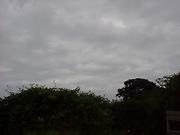
First contact... at least I think the camera is pointing at the Sun
 Wed 11 Aug 1999 Europe/London
Wed 11 Aug 1999 Europe/London
Eclipse Day! Well, the day dawned bright and... well, the day dawned, technically.
Clouds, clouds, and forecasts of more clouds was the order of the day. So rather than sit at home and hope for the best, we decided to head for the North coast at Porthtowan and look for clear skies.
We took a picture of First Contact from base camp, and set off at about 10:15 for Porthtowan. The radio was reporting that roads down into the Lizard were busy, but as we headed up over the A30 and up the country lanes, there was hardly another car in sight. Unfortunately, there wasn't a gap in the clouds in sight, either.
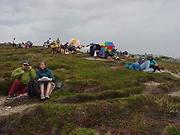
Eclipse-chasers on the headland
Getting into Porthtowan, there were signs of life at last; the car parks were pretty full. We hiked up to the headland overlooking the beach and found a reasonable crowd of two or three hundred hardy folk. The Sun was still behind dense clouds; it literally wasn't possible to tell what direction it was in. (We used a compass to take a picture of the "partial eclipse".)
Once or twice, the clouds thinned a little, and we got a few pictures and videos of the crescent Sun. It was still so dim it was hardly visible, though.
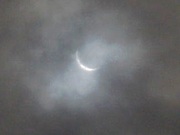
Getting close to totality
As the moment of totality approached, the light level dropped noticeably, and it started to turn chilly. A couple of minutes before totality, it was still fairly light; but it started getting gloomier and gloomier, with an eerie quality to the light quite unlike a normal dusk. The temperature also dropped noticeably. Then very rapidly the light vanished, down to almost nighttime levels; only in the north, we could see the horizon still dimly lit (we were to the north of the eclipse track).
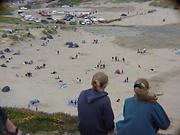
Crowds on the beach
A big cheer went up from the crowd as darkness fell; we could see all the towns along the coast suddenly light up as their automatic streetlights came on, and the flashlights of people's cameras were visible from miles away (stupid people! What did they think a flashlight would do apart from dazzle people?)
As totality ended, another cheer greeted the returning light, which came back as quickly as it had vanished. There wasn't any clear edge to the shadow, due to the heavy clouds dispersing the light; but very soon the light was back up, and it started getting noticeably warmer.
And that was it, all over until 2090. Of course, later we heard that a couple of places in Cornwall had a glimpse of totality through breaks in the clouds; given how dense the clouds were, with just a couple of rifts, that was just a matter of luck. So we consoled ourselves by watching the action replay on TV, and going for a post-eclipse barbecue (in the rain, of course).


